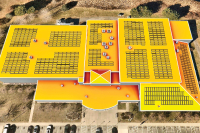Why the Easter bunny brings eggs
Did you ever wonder why this big, furry, long-eared mammal was hoping around with eggs in its basket?
The reason is the bunny was once a bird. Ancient Egyptians and Persians believed the heavens were ruled by sacred Phoenix birds. However, there was a struggle and rival gods struck down the birds. The Phoenix birds were reincarnated on Earth as rabbits. But these rabbits were special; they had the ability to lay eggs.
Ancient Saxons had their own egg-laying rabbit. In this version, a bird whose wings had been frozen by the cold winter, saved the goddess Eostre. The event turned the flightless bird into a rabbit — a rabbit that could lay eggs.
It’s no coincidence that these egg-laying rabbits were celebrated each year at the vernal equinox, when the northern hemisphere begins to turn back to the warming rays of the sun. This is the time to celebrate rebirth and the fecund Earth. The egg celebrates new life and the rabbit is a sign of fertility.
Legend has it that early Anglo-Saxons painted their hopes and dreams on eggs and offered them to Eostre. The eggs were buried so the Earth-Mother could know the dreams of her children.
Related Items
The Canaanites were some of the first Easter egg hunters. Early on the first Sunday morning of the vernal equinox, Canaanite families would face the east, awaiting the arrival of Baal, the sun god. Later in the day the children would go out and search for eggs, believed to be from rabbits.
As with so many pagan celebrations, this equinox celebration was assimilated into the Christian religion. There was much conflict regarding the proper date for this new (Easter) celebration. Much of the conflict and confusion was created by the differences between the Jewish calendar and the Christian calendar.
These differences were addressed at the Nicene Council in 325 A.D., and the Roman Catholic Church decreed that Easter would fall on the first Sunday after the first full moon of the vernal equinox. If that full moon fell on a Sunday, Easter would be celebrated the next Sunday. It must have been just a little too pagan to celebrate on a full moon.
At 8:07 p.m. Eastern Daylight Time, March 20, the sun will be directly above the Earth’s equator. This is the moment of the equinox. For those of us in the Northern Hemisphere, this will be the vernal equinox. For those in the Southern Hemisphere, it will be the autumnal equinox.
The first full moon after the equinox will be April 2, and Easter will be the following Sunday, April 9. Whether yours is a Christian celebration or a pagan celebration, the time from the equinox through Easter is a time steeped in the celebration of rebirth and revival as we turn back to the sun and its life-affirming warmth.
In this time when turmoil, strife and violence are running rampant across the planet, it would serve us well to acknowledge this season of rebirth and revival. Whether you pray to Christ, Mohammed, Baal, or Mother Earth, offer a plea that the seeds of love and tolerance fall in our fecund hearts and take root.
Oh, and leave some birdseed out for the Easter Bunny.









